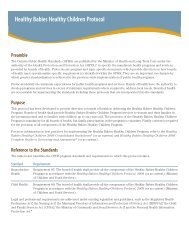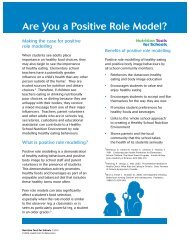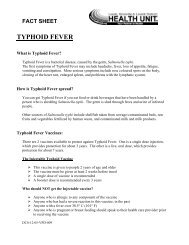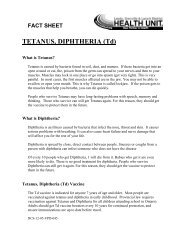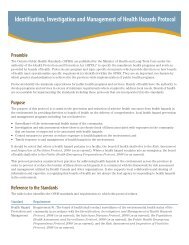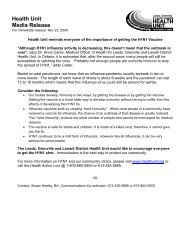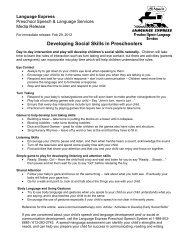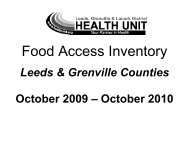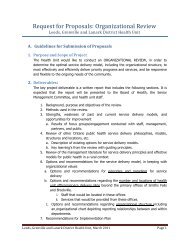Pediatric Nutrition Guidelines for Primary Health Care Providers
Pediatric Nutrition Guidelines for Primary Health Care Providers
Pediatric Nutrition Guidelines for Primary Health Care Providers
You also want an ePaper? Increase the reach of your titles
YUMPU automatically turns print PDFs into web optimized ePapers that Google loves.
<strong>Pediatric</strong> <strong>Nutrition</strong> <strong>Guidelines</strong> <strong>for</strong> <strong>Primary</strong> <strong>Health</strong> <strong>Care</strong> <strong>Providers</strong><br />
4<br />
If child presents with a red flag, further investigation is recommended. Referral to a registered dietitian (RD) <strong>for</strong> nutrition assessment and ongoing follow-up may be advised.<br />
Age<br />
Developmental milestones<br />
related to feeding<br />
<strong>Guidelines</strong><br />
Red flags<br />
12 to 24<br />
months<br />
Note:<br />
Milestones<br />
and<br />
guidelines<br />
<strong>for</strong> pre-term<br />
children are<br />
based on<br />
corrected<br />
age 1<br />
12 to 18 months<br />
Growth slows compared with the<br />
first year of life resulting in<br />
decreased or sporadic appetite 2<br />
See Parenting and the feeding<br />
relationship section on page 7<br />
Unfamiliar foods are often rejected<br />
the first time 2<br />
By 15 months, can self-feed with<br />
spoon and firmer table foods 2<br />
18 to 24 months<br />
Able to consume most of the same<br />
foods as the rest of the family with<br />
some extra preparation <strong>for</strong><br />
prevention of choking 2<br />
Fluctuating appetite and playing<br />
with food is common 2 . See<br />
Parenting and the feeding<br />
relationship section on page 7<br />
May refuse all but 4-5 foods,<br />
consume only preferred foods and<br />
refuse previously accepted foods 2 <br />
<br />
<br />
<br />
<br />
<br />
<br />
<br />
<br />
<br />
<br />
Continue to breastfeed 2,5<br />
If not breastfeeding, offer<br />
Avoid skim, 1% or 2% milk<br />
Offer 500-750 mL (2-3 cups)<br />
breast milk each day 3<br />
Serve 3 small meals and<br />
additional food or beverages<br />
planned meals and snacks<br />
Offer water when child is<br />
If juice is provided, offer 100%<br />
mL (4-6 oz) per day 2<br />
Avoid fruit drinks that are<br />
By 15 months, wean from<br />
Allow child to self-feed 2<br />
If breast milk is their only<br />
a vitamin D supplement 2<br />
Consider offering a vitamin/mineral<br />
is not growing well, has a<br />
requires it, and/or is not eating<br />
each of the food groups 2 <br />
<br />
<br />
<br />
<br />
<br />
<br />
<br />
<br />
Growth measures plotted at < 3<br />
percentile OR sharp incline or decline<br />
growth in serial growth measures,<br />
growth-line that remains flat, on<br />
Growth Charts <strong>for</strong> Canada 11<br />
Not eating a variety of table foods<br />
including iron containing foods<br />
Dietary fat intake is restricted 5<br />
Lumpy or textured foods are refused<br />
Skim milk, low fat milk or soy beverage<br />
regularly given 5<br />
Soy (except <strong>for</strong>mula), rice, other<br />
vegetarian beverages or herbal<br />
are given 5<br />
Consumes large amount of fluids<br />
little food 2<br />
- Milk: > 750 mL (3 cups) a day<br />
- Juice: > 175 mL (6 oz) a day<br />
Regularly consumes fruit drinks,<br />
coffee, tea, cola, hot chocolate,<br />
beverage, other vegetarian beverages<br />
(e.g., rice or almond beverage)<br />
teas 2,5<br />
Feeding is <strong>for</strong>ced or restricted 2<br />
not 100% juice and pop 2<br />
bottle 2<br />
teas<br />
and very<br />
milk source, consider offering<br />
supplement if child<br />
specific health condition that<br />
a variety of foods from<br />
pop,<br />
soy<br />
whole (3.25%) cow’s milk. 2,16<br />
in<br />
5<br />
or a<br />
per day of 3.25% milk or<br />
the WHO<br />
2-3 snacks a day 3 . Avoid<br />
except water between<br />
daily 5<br />
2,3<br />
thirsty 2<br />
juice and limit to 125-175<br />
or herbal<br />
Produced by the Ontario Society of <strong>Nutrition</strong> Professionals in Public <strong>Health</strong> (OSNPPH) – Family <strong>Health</strong> <strong>Nutrition</strong> Advisory Group. Revised May 2011.



